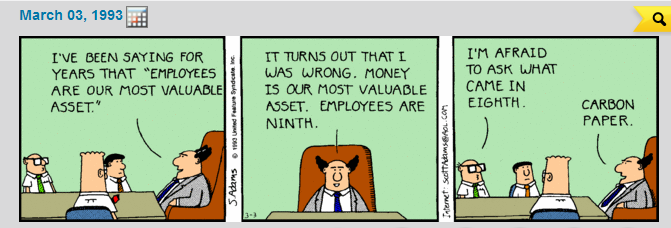|
How One Accounting Rule Wrecked The Middle Class
Featured in Zero Hedge Daniel Drew, 6/12/2015 Tweet  Maybe you heard your CEO say, "Our people are our greatest asset." He's probably lying. That's not how he really feels about you. Despite how much management talks about "human capital" as if it were an asset, it's not. The accounting system that the whole world uses classifies labor as an expense. Anyone who has studied accounting even briefly can see that it's a lot of bullshit designed to appear objective. In reality, it is filled with assumptions, estimates, and sometimes, fraud. Yes, it is rule-based, but with any system, who makes the rules is often more important than the rules themselves. Accounting is the language of business, and in the mouth of a double-talking CEO, it's just another way to promote their own interests. One of the most insidious rules in accounting is that labor must be classified as an expense on the income statement. Actually, it should be classified as an asset on the balance sheet. The accounting profession has rigged the system against the worker. The misclassification of labor as an expense has branded every employee with a negative dollar sign. The way the accounting system defines labor causes CEOs and upper management to view employees as expendable. When profits decline, the CEO says, "It must be those damned employees dragging us down! Let's fire a few thousand of them. That will get us on track again." According to current accounting rules, inanimate objects like pencils, clothing, or any type of inventory are assets, but people are expenses. The CEOs want you to believe that a pen is an asset, but a person with knowledge, skills, and experience is an expense, something that should be avoided. This is actually what they teach business students in school all around the world, and the students just accept it as fact. Have we all gone insane? We are being held captive by dumbass accountants and shrewd CEOs who realize the whole system is rigged in their favor. The proper way to account for labor would be to classify it as an asset on the balance sheet. The employee would be valued with mark to market accounting at every reporting period, and the value would be determined by calculating the profit per employee, the average tenure, and the net present value of this amount. This would accurately account for the true value of labor. If this rule were implemented, balance sheets would be dramatically altered. Some companies that appeared valuable before might look like complete garbage. Other companies would prove to be much more valuable than previously thought. One company that understands the true value of employees is Costco. Their full-time employees make $43,000 per year, which is very high for the retail industry. The turnover there is only 5% for employees who have been there a year or longer. In 2004, The Wall Street Journal published an article about Costco's skeptics. Bill Dreher, retail analyst at Deutsche Bank, said, "From the perspective of investors, Costco's benefits are overly generous. Public companies need to care for shareholders first." Dreher said profit margins weren't as high as they should be. However, Costco CEO Jim Sinegal, who owned 3.2 million shares of Costco at the time, said, The last thing I want people to believe is that I don't care about the shareholder. But I happen to believe that in order to reward the shareholder in the long term, you have to please your customers and workers.The CFO, Richard Galanti, agreed, From day one, we've run the company with the philosophy that if we pay better than average, provide a salary people can live on, have a positive environment and good benefits, we'll be able to hire better people, they'll stay longer and be more efficient.A study in the Harvard Business Review showed that Costco generated $21,805 in U.S. operating profit per hourly employee, compared with $11,615 at Sam's Club, a Walmart subsidiary. John Bowen, an investment manager and Costco shareholder, said, "Happy employees make for happy customers, which in the long run is ultimately reflected in the share price." Fortunately, the Costco CEO didn't listen to the Deutsche Bank analyst who was complaining about their labor investments. In the last 5 years, Costco stock has risen by 139%. Walmart has only gained 41%. What's interesting about the reclassification of labor as an asset is the implication for central bank policy. The federal minimum wage is only $7.25. Those in power don't see that as a problem. However, when asset prices decline, all of a sudden, they start worrying about deflation. That's why the Federal Reserve launched multiple rounds of quantitative easing, a policy which has essentially become QE Infinity. While there is no official minimum stock market level like there is with the minimum wage, it's quite clear there is a de facto minimum level, and I guarantee you it's not $7.25. The Chicago Mercantile Exchange's "central bank incentive program" has proven that central banks buy S&P; 500 futures to prop up the market. If labor is no longer misclassified as an expense, would the value of labor rise with all the other assets being inflated by quantitative easing? |